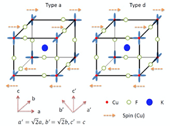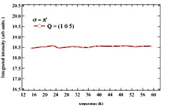Volume5 No.2
SPring-8 Section A: Scientific Research Report
Magnetic and Orbital Ordering of KCuF3 Studied by Resonant X-ray Scattering
aNational Tsing Hua Univ., bNSRRC, cTamkang Univ., dKEK CMRC/PF
- Abstract
-
We have studied the magnetic and orbital orderings in Cu 3d orbitals of KCuF3 by using Cu K-edge resonant X-ray scattering. For the orbital reflection (1 0 5) at quadrupole transition, however, no cleartransition was observed about 40 K. This shows that the coupling between spins and orbitals in Cu 3d orbitalsis small in type-a orbital ordering of KCuF3.
Keywords: orbital ordering, resonant X-ray scattering, polarization analysis
Background and Purpose
One of the hot subjects in the research of strongly correlated electron systems is the interplay between charge, orbital and spin degrees of freedoms. The magnetic and orbital properties of the pseudocubic perovskite KCuF3 have been studied in the past half century [1-6]. The charge-transfer insulator KCuF3 is an archetype of orbital ordered material with large exchange interaction energy. KCuF3 has been known to show one-dimensional quantum antiferromagnetic properties along c axis originating from the super-exchange interaction between the eg orbitals of Cu2+. Because of the Jahn-Teller distortion in the tetragonal structure, the degeneracy of the two eg orbitals forms a pattern of orbital ordering. There are two mechanisms of orbital ordering [7,8]; First, electron-phonon coupling gives rise to Jahn-Teller distortion and then produces orbital ordering. Second, the super-exchange interaction leads to orbital ordering and then produces Jahn-Teller distortion. In the second one, orbital ordering can be enhanced by the presence of magnetic ordering. Therefore, the study of relations between magnetic and orbital orderings has been interested.
Figure 1 illustrates the two-different stacking of orbital orderings of KCuF3. They form two types of antiferromagnetic structures (type-a and type-d) in KCuF3. Neel temperature of these two structures are 38±1 K and 22±4 K for type-a and type-d, respectively [1].
Several resonant hard X-ray scattering (RXS) measurements have been done at the Cu K-edge to study the magnetic and orbital orderings in the Cu orbitals. For magnetic ordering, RXS peak appears below Neel temperature of 38 K and increases its intensity as temperature decreases. As for orbital ordering, its RXS peak intensity is constant down to 43 K but increases below this temperature and saturates below Neel temperature [2,3]. These observations show close relationship between magnetic and orbital orderings at low temperature, such as two-stage orbital ordering [9]. But in these RXS measurements, magnetic orderings show finite RXS intensities at the photon energies of both the electric dipole transition (1s → 4p) and the quadrupole transition (1s → 3d), but orbital orderings show finite RXS intensity only at the photon energies at the electric dipole transitions [2,3,10]. Orbital ordering in the Cu 3d orbitals is reflected in the RXS orbital ordering peak observe at the Cu K-edge quadrupole transition, but it has not studied precisely yet.
We have so far studied magnetic ordering of KCuF3 in the Cu 3d orbitals directly by using resonant soft Xray scattering at the Cu L3-edge [11]. As shown in Fig. 2, intensity of magnetic reflection at (0 0 1) increases below Neel temperature, which matches with reported Cu K-edge RXS data [2,3].
We have done Cu K-edge RXS measurement on the same sample with polarization analysis technique and tuned incident photon energy at the quadrupole transition to study the detail properties of magnetic and orbital orderings at the Cu 3d orbitals in KCuF3.
Experimental Summary
KCuF3 single crystal is prepared by Murakami Group at KEK; first KCuF3 poly crystals were grown by aqueous solution precipitation method and then KCuF3 single crystal was fabricated from the poly crystals by the Bridgman method in an Ar atmosphere. KCuF3 single crystal is grown by controlling temperature gradient of the cell not by moving sample position in order to avoid the influence of motor vibration on sample quality. We did RXS measurement of type-a KCuF3 single crystal at the Cu K-edge at the BL12B2 beamline. Figure 3 shows the schematic representation of experimental setup. In order to suppress the intensity of charge reflection, we used LiF (0 0 4) as an analyzer crystal which satisfies the depolarize geometry condition at Cu K-edge. We choose the perovskite structure (a’ = b’ = 5.856 Å,
c’ = 7.847 Å) as a unit cell in our experiment. The two different stacking of orbital orderings in KCuF3 form two orbital reflections (1 0 5) for type-a and (1 0 4) for type-d.
Results and Discussion
First we compared X-ray absorption spectroscopy (XAS) and diffraction anomalous fine structure (DAFS) of orbital ordering (1 0 5) for type-a at Cu K-edge. Figure 4(a) shows that the integrated intensity of the orbital ordering for type-a is enhanced drastically when the photon energy is tuned near the electric dipole transition (1s → 4p; 8995 eV), although it was less pronounced at the quadrupole transition (1s → 3d; 8980 eV)around the Cu K-edge. The DAFS line is consistent with the other data [2,3], although measuring differentorbital reflections.
We also compared the intensity of two orbital reflections (1 0 5) for type-a and (1 0 4) for type-d to examinethe quality of KCuF3 setting incident photon energy at the Cu K-edge peak of 8995 eV. Figure 4 (b) represents the σ-π’ orbital diffraction intensities of type-a (1 0 5) and type-d (1 0 4) structures. We found that the intensity of orbital ordering from type-d was about 0.3 % of that from type-a. This observation suggests that our sampleis a nearly pure type-a single crystal.
In order to study the coupling between magnetic and orbital orderings in Cu 3d electronic structures, we have done RXS measurement of orbital ordering for type-a (1 0 5) by tuning photon energy at the quadrupole transition of Cu (1s → 3d) about 8980 eV. Figure 5 shows temperature dependence of scattering intensity at momentum transfer Q = (1 0 5) from 12 K to 60 K. No clear intensity drop was observed at magnetic transition temperature at 38 K, which was different from the reported data at dipole transition photon energy [2-3]. Our result shows that the coupling between spin and orbital degree of freedom in Cu 3d electronic structures is small in type-a orbital ordering of KCuF3.
Challenges
Since Cu 3d eg unoccupied states are narrow, we may need more precise check for selecting incident photon energies in the quadrupole transition.
References
[1] M. Ikebe, M. Date, J. Phys. Soc. Jpn. 30, 93 (1971).
[2] R. Caciuffo, L. Paolasini, A. Sollier, P. Ghigna, E. Pavarini, J. van den Brink, M. Altarelli, Phys. Rev. B 65, 174425 (2002).
[3] L. Paolasini, R. Caciuffo, A. Sollier, P. Ghigna, M. Altarelli, Phys. Rev. Lett. 88, 106403 (2002).
[4] M. Takahashi, M. Usuda, J. Igarashi, Phys. Rev. B 67, 064425 (2003).
[5] N. Binggeli, M. Altarelli, Phys. Rev. B 70, 085117 (2004).
[6] K. Ishii, S. Ishihara, Y. Murakami, K. Ikeuchi, K. Kuzushita, T. Inami, K. Ohwada, M. Yoshida, I. Jarrige, N. Tatami, S. Niioka, D. Bizen, Y. Ando, J. Mizuki, S. Maekawa, Y. Endoh, Phys. Rev. B 83, 241101(2011).
[7] J. Kanamori, J. of Appl. Phys. 31, S14 (1960).
[8] K. I. Kugel, D. I. Khomskii, Sov. Phys.-JETP 37, 725 (1974).
[9] J. T. Lee, S. Yuan, S. Lal, Y. I. Joe, Y. Gan, S. Smadici, K. Finkelstein, Y. Feng, A. Rusydi, P. M. Goldbart, S. L. Cooper, P. Abbamonte, Nat. Phys. 8, 63 (2012).
[10] C. Mazzoli, L. Paolasini, F. de. Bergevin, P. Ghigna, R. Caciuffo, Physica B 378-380, 563 (2006).
[11] C. H. Lai, Ph. D thesis, National Tsing-Hua University (2014).

Fig. 1 Schematic views of atomic, spin, and orbital patterns of KCuF3; antiferro-ordered orbital pattern for type-a structure (left) and ferro-ordered orbital pattern for type-d structure (right), respectively.

Fig. 2 Momentum scans of resonant soft X-ray scattering of KCuF3 for the magnetic reflection (0 0 1) along out of plane direction [11]. The incident photon energy is set at Cu L3 edge.

Fig. 3 Schematic illustration of experimental setup for RXS measurement.

Fig. 4 (a) XAS and integrated intensity of the orbital reflection (1 0 5) spectra of KCuF3. (b) Diffraction peaks of orbital ordering. The blue and red lines are orbital reflections of (1 0 4) for type-d and (1 0 5) for type-a, respectively.

Fig. 5 Temperature dependence of integrated scattering intensity at (1 0 5) in σ (photon-in) - π' (photon-out) channel.
ⒸJASRI
(Received: September 30, 2016; Early edition: March 24, 2017; Accepted: July 18, 2017; Published: August 17, 2017)






